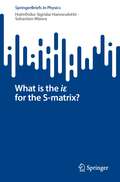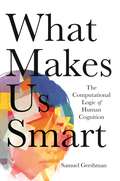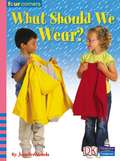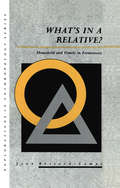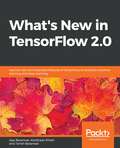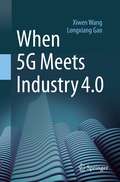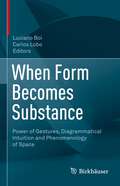- Table View
- List View
What Is Random?: Chance and Order in Mathematics and Life (Copernicus Ser.)
by Edward BeltramiIn this fascinating book, mathematician Ed Beltrami takes a close enough look at randomness to make it mysteriously disappear. The results of coin tosses, it turns out, are determined from the start, and only our incomplete knowledge makes them look random. "Random" sequences of numbers are more elusive, but Godels undecidability theorem informs us that we will never know. Those familiar with quantum indeterminacy assert that order is an illusion, and that the world is fundamentally random. Yet randomness is also an illusion. Perhaps order and randomness, like waves and particles, are only two sides of the same (tossed) coin.
What Is Random?: Chance and Order in Mathematics and Life (Copernicus Ser.)
by Edward BeltramiIn this fascinating book, mathematician Ed Beltrami takes a close enough look at randomness to make it mysteriously disappear. The results of coin tosses, it turns out, are determined from the start, and only our incomplete knowledge makes them look random. "Random" sequences of numbers are more elusive, but Godels undecidability theorem informs us that we will never know. Those familiar with quantum indeterminacy assert that order is an illusion, and that the world is fundamentally random. Yet randomness is also an illusion. Perhaps order and randomness, like waves and particles, are only two sides of the same (tossed) coin.
What is the Genus? (Lecture Notes in Mathematics #2162)
by Patrick Popescu-PampuExploring several of the evolutionary branches of the mathematical notion of genus, this book traces the idea from its prehistory in problems of integration, through algebraic curves and their associated Riemann surfaces, into algebraic surfaces, and finally into higher dimensions. Its importance in analysis, algebraic geometry, number theory and topology is emphasized through many theorems. Almost every chapter is organized around excerpts from a research paper in which a new perspective was brought on the genus or on one of the objects to which this notion applies. The author was motivated by the belief that a subject may best be understood and communicated by studying its broad lines of development, feeling the way one arrives at the definitions of its fundamental notions, and appreciating the amount of effort spent in order to explore its phenomena.
What is the iε for the S-matrix? (SpringerBriefs in Physics)
by Holmfridur Sigridar Hannesdottir Sebastian MizeraThis book provides a modern perspective on the analytic structure of scattering amplitudes in quantum field theory, with the goal of understanding and exploiting consequences of unitarity, causality, and locality. It focuses on the question: Can the S-matrix be complexified in a way consistent with causality? The affirmative answer has been well understood since the 1960s, in the case of 2→2 scattering of the lightest particle in theories with a mass gap at low momentum transfer, where the S-matrix is analytic everywhere except at normal-threshold branch cuts. We ask whether an analogous picture extends to realistic theories, such as the Standard Model, that include massless fields, UV/IR divergences, and unstable particles. Especially in the presence of light states running in the loops, the traditional iε prescription for approaching physical regions might break down, because causality requirements for the individual Feynman diagrams can be mutually incompatible. We demonstrate that such analyticity problems are not in contradiction with unitarity. Instead, they should be thought of as finite-width effects that disappear in the idealized 2→2 scattering amplitudes with no unstable particles, but might persist at higher multiplicity. To fix these issues, we propose an iε-like prescription for deforming branch cuts in the space of Mandelstam invariants without modifying the analytic properties of the physical amplitude. This procedure results in a complex strip around the real part of the kinematic space, where the S-matrix remains causal. We illustrate all the points on explicit examples, both symbolically and numerically, in addition to giving a pedagogical introduction to the analytic properties of the perturbative S-matrix from a modern point of view. To help with the investigation of related questions, we introduce a number of tools, including holomorphic cutting rules, new approaches to dispersion relations, as well as formulae for local behavior of Feynman integrals near branch points. This book is well suited for anyone with knowledge of quantum field theory at a graduate level who wants to become familiar with the complex-analytic structure of Feynman integrals.
What Makes Us Smart: The Computational Logic of Human Cognition
by Samuel GershmanHow a computational framework can account for the successes and failures of human cognitionAt the heart of human intelligence rests a fundamental puzzle: How are we incredibly smart and stupid at the same time? No existing machine can match the power and flexibility of human perception, language, and reasoning. Yet, we routinely commit errors that reveal the failures of our thought processes. What Makes Us Smart makes sense of this paradox by arguing that our cognitive errors are not haphazard. Rather, they are the inevitable consequences of a brain optimized for efficient inference and decision making within the constraints of time, energy, and memory—in other words, data and resource limitations. Framing human intelligence in terms of these constraints, Samuel Gershman shows how a deeper computational logic underpins the “stupid” errors of human cognition.Embarking on a journey across psychology, neuroscience, computer science, linguistics, and economics, Gershman presents unifying principles that govern human intelligence. First, inductive bias: any system that makes inferences based on limited data must constrain its hypotheses in some way before observing data. Second, approximation bias: any system that makes inferences and decisions with limited resources must make approximations. Applying these principles to a range of computational errors made by humans, Gershman demonstrates that intelligent systems designed to meet these constraints yield characteristically human errors.Examining how humans make intelligent and maladaptive decisions, What Makes Us Smart delves into the successes and failures of cognition.
What Makes Us Smart: The Computational Logic of Human Cognition
by Samuel GershmanHow a computational framework can account for the successes and failures of human cognitionAt the heart of human intelligence rests a fundamental puzzle: How are we incredibly smart and stupid at the same time? No existing machine can match the power and flexibility of human perception, language, and reasoning. Yet, we routinely commit errors that reveal the failures of our thought processes. What Makes Us Smart makes sense of this paradox by arguing that our cognitive errors are not haphazard. Rather, they are the inevitable consequences of a brain optimized for efficient inference and decision making within the constraints of time, energy, and memory—in other words, data and resource limitations. Framing human intelligence in terms of these constraints, Samuel Gershman shows how a deeper computational logic underpins the “stupid” errors of human cognition.Embarking on a journey across psychology, neuroscience, computer science, linguistics, and economics, Gershman presents unifying principles that govern human intelligence. First, inductive bias: any system that makes inferences based on limited data must constrain its hypotheses in some way before observing data. Second, approximation bias: any system that makes inferences and decisions with limited resources must make approximations. Applying these principles to a range of computational errors made by humans, Gershman demonstrates that intelligent systems designed to meet these constraints yield characteristically human errors.Examining how humans make intelligent and maladaptive decisions, What Makes Us Smart delves into the successes and failures of cognition.
What Makes Variables Random: Probability for the Applied Researcher
by Peter J. VeazieWhat Makes Variables Random: Probability for the Applied Researcher provides an introduction to the foundations of probability that underlie the statistical analyses used in applied research. By explaining probability in terms of measure theory, it gives the applied researchers a conceptual framework to guide statistical modeling and analysis, and to better understand and interpret results. The book provides a conceptual understanding of probability and its structure. It is intended to augment existing calculus-based textbooks on probability and statistics and is specifically targeted to researchers and advanced undergraduate and graduate students in the applied research fields of the social sciences, psychology, and health and healthcare sciences. Materials are presented in three sections. The first section provides an overall introduction and presents some mathematical concepts used throughout the rest of the text. The second section presents the basic structure of measure theory and its special case of probability theory. The third section provides the connection between a conceptual understanding of measure-theoretic probability and applied research. This section starts with a chapter on its use in understanding basic models and finishes with a chapter that focuses on more complicated problems, particularly those related to various types and definitions of analyses related to hierarchical modeling.
What Makes Variables Random: Probability for the Applied Researcher
by Peter J. VeazieWhat Makes Variables Random: Probability for the Applied Researcher provides an introduction to the foundations of probability that underlie the statistical analyses used in applied research. By explaining probability in terms of measure theory, it gives the applied researchers a conceptual framework to guide statistical modeling and analysis, and to better understand and interpret results. The book provides a conceptual understanding of probability and its structure. It is intended to augment existing calculus-based textbooks on probability and statistics and is specifically targeted to researchers and advanced undergraduate and graduate students in the applied research fields of the social sciences, psychology, and health and healthcare sciences. Materials are presented in three sections. The first section provides an overall introduction and presents some mathematical concepts used throughout the rest of the text. The second section presents the basic structure of measure theory and its special case of probability theory. The third section provides the connection between a conceptual understanding of measure-theoretic probability and applied research. This section starts with a chapter on its use in understanding basic models and finishes with a chapter that focuses on more complicated problems, particularly those related to various types and definitions of analyses related to hierarchical modeling.
What Mathematics Can Do for You: Essays and Tips from Japanese Industry Leaders
by Yoshikazu Giga and Toshiyuki KobayashiJapan is a tiny country that occupies only 0.25% of the world’s total land area. However, this small country is the world’s third largest in economy: the Japanese GDP is roughly equivalent to the sum of any two major countries in Europe as of 2012.This book is a first attempt to ask leaders of top Japanese companies, such as Toyota, about their thoughts on mathematics. The topics range from mathematical problems in specific areas (e.g., exploration of natural resources, communication networks, finance) to mathematical strategy that helps a leader who has to weigh many different issues and make decisions in a timely manner, and even to mathematical literacy that ensures quality control. The reader may notice that every article reflects the authors’ way of life and thinking, which can be evident in even one sentence.This book is an enlarged English edition of the Japanese book What Mathematics Can Do for You: Essays and Tips from Japanese Industry Leaders. In this edition we have invited the contributions of three mathematicians who have been working to expand and strengthen the interaction between mathematics and industry.The role of mathematics is usually invisible when it is applied effectively and smoothly in science and technology, and mathematical strategy is often hidden when it is used properly and successfully. The business leaders in successful top Japanese companies are well aware of this invisible feature of mathematics in applications aside from the intrinsic depth of mathematics. What Mathematics Can Do for You ultimately provides the reader an opportunity to notice what is hidden but key to business strategy.
What Matters? Research Trends in International Comparative Studies in Mathematics Education (Research in Mathematics Education)
by Ji-Won Son Tad Watanabe Jane-Jane LoThis book provides a unique international comparative perspective on diverse issues and practices in mathematics education between and among the US and five high-performing TIMSS education systems, Japan, China, Singapore, South Korea, and Taiwan. The book offers multiple perspectives on the important factors that contribute to mathematics teaching and learning in different educational systems and cultural contexts. Using large scale data generated by numerous international comparative studies, the book analyzes and provides context for various methodological perspectives. The book raises compelling questions and issues for mathematics education researchers, leading to a critical examination of what can be learned from other education systems. Authors address four major research perspectives by critically examining cross-national similarities and differences, such as research on the influence of curriculum on student learning; research on institutional systems of mathematics teacher education; research on improving teacher knowledge and pedagogical approaches; and research using large-scale data. This collection of perspectives serves as a foundation for reviewing and analyzing the international comparative studies introduced in the book.
What Should We Wear? (PDF)
by Jennifer NicholsWhat Should We Wear? Four Corners The widest cross-curricular coverage including science, history, geography and mathematics themes all clearly linked to the National Curriculum Programmes for Study and the 5-14. Guidelines for Scotland. Visually inspire all readers with unparalleled Dorling Kindersley photography and design. Engage and satisfy the curiosity of all readers with lively writing styles and broad range of topics and subjects that provides something to interest and motivate every child! Extend teaching imaginatively with speaking and listening, drama and writing activities which are provided in the teaching support for every title. Constructive links to Art, Design and Technology, Music, Citizenship and PSHE are drawn out with practical suggestions for all titles in the teaching support. Easy to use for teachers and teaching assistants with laminated teaching support and activity cards (in every pack of 6) that draw out all NLS links and extension opportunities simply and effectively. Support for parents and homework activities provided in the Teacher's Files.
What We Cannot Know: Explorations At The Edge Of Knowledge
by Marcus du Sautoy‘Brilliant and fascinating. No one is better at making the recondite accessible and exciting’ Bill Bryson Britain’s most famous mathematician takes us to the edge of knowledge to show us what we cannot know.
Whatever Happened to the Metric System?: How America Kept Its Feet
by John Bemelmans MarcianoThe intriguing tale of why the United States has never adopted the metric system, and what that says about us.The American standard system of measurement is a unique and odd thing to behold with its esoteric, inconsistent standards: twelve inches in a foot, three feet in a yard, sixteen ounces in a pound, one hundred pennies to the dollar. For something as elemental as counting and estimating the world around us, it seems like a confusing tool to use. So how did we end up with it?Most of the rest of the world is on the metric system, and for a time in the 1970s America appeared ready to make the switch. Yet it never happened, and the reasons for that get to the root of who we think we are, just as the measurements are woven into the ways we think. John Marciano chronicles the origins of measurement systems, the kaleidoscopic array of standards throughout Europe and the thirteen American colonies, the combination of intellect and circumstance that resulted in the metric system's creation in France in the wake of the French Revolution, and America's stubborn adherence to the hybrid United States Customary System ever since. As much as it is a tale of quarters and tenths, it is a human drama, replete with great inventors, visionary presidents, obsessive activists, and science-loving technocrats.Anyone who reads this inquisitive, engaging story will never read Robert Frost's line "miles to go before I sleep†? or eat a foot-long sub again without wondering, Whatever happened to the metric system?
What's in a Relative: Household and Family in Formentera
by Joan Bestard-CampsIn this ground-breaking study based on ethnographic research in Formentera, in the Balearic Islands, the author demonstrates that European kinship can become central to anthropological explanation once it is understood from a symbolic and cultural perspective. This book is an outstanding example of ethnographic analysis which is sensitive to the findings of demographic and historical research.
What's in a Relative: Household and Family in Formentera
by Joan Bestard-CampsIn this ground-breaking study based on ethnographic research in Formentera, in the Balearic Islands, the author demonstrates that European kinship can become central to anthropological explanation once it is understood from a symbolic and cultural perspective. This book is an outstanding example of ethnographic analysis which is sensitive to the findings of demographic and historical research.
What's Luck Got to Do with It?: The History, Mathematics, and Psychology of the Gambler's Illusion
by Joseph MazurWhy do so many gamblers risk it all when they know the odds of winning are against them? Why do they believe dice are "hot" in a winning streak? Why do we expect heads on a coin toss after several flips have turned up tails? What's Luck Got to Do with It? takes a lively and eye-opening look at the mathematics, history, and psychology of gambling to reveal the most widely held misconceptions about luck. It exposes the hazards of feeling lucky, and uses the mathematics of predictable outcomes to show when our chances of winning are actually good. Mathematician Joseph Mazur traces the history of gambling from the earliest known archaeological evidence of dice playing among Neolithic peoples to the first systematic mathematical studies of games of chance during the Renaissance, from government-administered lotteries to the glittering seductions of grand casinos, and on to the global economic crisis brought on by financiers' trillion-dollar bets. Using plenty of engaging anecdotes, Mazur explains the mathematics behind gambling--including the laws of probability, statistics, betting against expectations, and the law of large numbers--and describes the psychological and emotional factors that entice people to put their faith in winning that ever-elusive jackpot despite its mathematical improbability. As entertaining as it is informative, What's Luck Got to Do with It? demonstrates the pervasive nature of our belief in luck and the deceptive psychology of winning and losing.
Whats New in TensorFlow 2.0: Use The New And Improved Features Of Tensorflow To Enhance Machine Learning And Deep Learning
by Ajay BaranwalThis book will cover all the new features that have been introduced in TensorFlow 2.0 especially the major highlight, including eager execution and more. You will learn how to make the best use of these features to migrate your codes from TensorFlow 1.x to TensorFlow 2.0 in a seamless way.
What's Next?: The Mathematical Legacy of William P. Thurston (AMS-205) (Annals of Mathematics Studies #380)
by Dylan ThurstonWilliam Thurston (1946–2012) was one of the great mathematicians of the twentieth century. He was a visionary whose extraordinary ideas revolutionized a broad range of areas of mathematics, from foliations, contact structures, and Teichmüller theory to automorphisms of surfaces, hyperbolic geometry, geometrization of 3-manifolds, geometric group theory, and rational maps. In addition, he discovered connections between disciplines that led to astonishing breakthroughs in mathematical understanding as well as the creation of entirely new fields. His far-reaching questions and conjectures led to enormous progress by other researchers. In What's Next?, many of today's leading mathematicians describe recent advances and future directions inspired by Thurston's transformative ideas.This book brings together papers delivered by his colleagues and former students at "What's Next? The Mathematical Legacy of Bill Thurston," a conference held in June 2014 at Cornell University. It discusses Thurston's fundamental contributions to topology, geometry, and dynamical systems and includes many deep and original contributions to the field. Incisive and wide-ranging, the book explores how he introduced new ways of thinking about and doing mathematics—innovations that have had a profound and lasting impact on the mathematical community as a whole—and also features two papers based on Thurston's unfinished work in dynamics.
What's Right About Wrong Answers: Learning From Math Mistakes, Grades 4-5
by Nancy AndersonYou can&’t learn to hit a three-point shot without missing a lot of shots. You can&’t learn to play a piece of music correctly without striking a lot of wrong notes. And, as Nancy Anderson explains in What&’s Right About Wrong Answers: Learning From Math Mistakes, Grades 4-5 , You can&’t learn math without making mistakes. Anderson turns mistakes on their head and helps you cleverly use them to students&’ advantage. Each of the twenty-two activities in this book focuses on important ideas in grades 4 5 mathematics. By examining comic strips, letters to a fictitious math expert from confused students, and sample student work containing mistakes, your learners explore typical math mistakes, reflect on why they&’re wrong, and move toward deeper understanding. Each activity includes: A summary of the mathematical content and highlighted error Common Core connections Prerequisite knowledge that students need Big underlying math ideas Suggestions for implementing the activity Each activity can be used to enhance units of instruction and help students prepare for assessments that are aligned with the Common Core and similar state standards.
What's Right About Wrong Answers: Learning From Math Mistakes, Grades 4-5
by Nancy AndersonYou can&’t learn to hit a three-point shot without missing a lot of shots. You can&’t learn to play a piece of music correctly without striking a lot of wrong notes. And, as Nancy Anderson explains in What&’s Right About Wrong Answers: Learning From Math Mistakes, Grades 4-5 , You can&’t learn math without making mistakes. Anderson turns mistakes on their head and helps you cleverly use them to students&’ advantage. Each of the twenty-two activities in this book focuses on important ideas in grades 4 5 mathematics. By examining comic strips, letters to a fictitious math expert from confused students, and sample student work containing mistakes, your learners explore typical math mistakes, reflect on why they&’re wrong, and move toward deeper understanding. Each activity includes: A summary of the mathematical content and highlighted error Common Core connections Prerequisite knowledge that students need Big underlying math ideas Suggestions for implementing the activity Each activity can be used to enhance units of instruction and help students prepare for assessments that are aligned with the Common Core and similar state standards.
When 5G Meets Industry 4.0
by Longxiang Gao Xiwen WangSince the 1980s, mobile communication has undergone major transitions from 1G to 4G, at a rate of roughly one generation per decade. And the next upgrade is set to come soon, with 5G heralding a new era of large-bandwidth Internet, and a multi-connection, low-latency Internet of Everything.5G technology will be the standard for next-generation mobile Internet, and it will not only enhance the individual user’s experience, but also provide technical support for artificial-intelligence-based applications, such as smart manufacturing, smart healthcare, smart government, smart cities and driverless cars. As a result, 5G is regarded as the “infrastructure” of the industrial Internet and artificial intelligence and both China and the United States are striving to become the 5G leader and spearhead this new generation of international mobile communication standards. Though trade tensions between China and the United States continue to escalate, with products ranging from soybeans to mobile phones and automobiles being affected, 5G technology may be the true cause of trade wars between the world’s top two economies.In short, 5G will change not only society, but also international trade patterns. This book describes various 5G scenarios, changes and values; explains the standards, technologies and development directions behind 5G; and explores new models, new formats and new trends in 5G-based artificial intelligence.
When Do I Take Which Distribution?: A Statistical Basis for Entrepreneurial Applications (SpringerBriefs in Business)
by Uwe Wehrspohn Dietmar ErnstThis book provides the statistical basis for quantitative risk management by presenting and explaining the most important distributions. Distributions describe the occurrence and impact of a risk. They are a prerequisite for risk aggregation, risk analysis and risk assessment as required by the German revision standards IDW PS 340, StaRUG and FISG.This book portrays the distributions that are fundamental for enterprise risk management and shows when and how they are used. These include the Bernoulli distribution, the binomial distribution, the Poisson distribution, the uniform distribution, the triangular distribution, the PERT distribution, the modified PERT distribution, the trapezoidal distribution, the custom distribution, the normal distribution, the lognormal distribution, the Weibull distribution, the expert distribution, the poly distribution and the compound distribution. Furthermore, the book explains how the parameterisation of the distributions can be done via expert estimates or algorithmic calibration.
When Does Bootstrap Work?: Asymptotic Results and Simulations (Lecture Notes in Statistics #77)
by Enno MammenWhen Form Becomes Substance: Power of Gestures, Diagrammatical Intuition and Phenomenology of Space
by Luciano Boi Carlos LoboThis interdisciplinary volume collects contributions from experts in their respective fields with as common theme diagrams.Diagrams play a fundamental role in the mathematical visualization and philosophical analysis of forms in space. Some of the most interesting and profound recent developments in contemporary sciences, whether in topology, geometry, dynamic systems theory, quantum field theory or string theory, have been made possible by the introduction of new types of diagrams, which, in addition to their essential role in the discovery of new classes of spaces and phenomena, have contributed to enriching and clarifying the meaning of the operations, structures and properties that are at the heart of these spaces and phenomena.The volume gives a closer look at the scope and the nature of diagrams as constituents of mathematical and physical thought, their function in contemporary artistic work, and appraise, in particular, the actual importance of the diagrams of knots, of braids, of fields, of interaction, of strings in topology and geometry, in quantum physics and in cosmology, but also in theory of perception, in plastic arts and in philosophy. The editors carefully curated this volume to be an inspiration to students and researchers in philosophy, phenomenology, mathematics and the sciences, as well as artists, musicians and the general interested audience.
When Least Is Best: How Mathematicians Discovered Many Clever Ways to Make Things as Small (or as Large) as Possible
by Paul J. NahinWhat is the best way to photograph a speeding bullet? Why does light move through glass in the least amount of time possible? How can lost hikers find their way out of a forest? What will rainbows look like in the future? Why do soap bubbles have a shape that gives them the least area? By combining the mathematical history of extrema with contemporary examples, Paul J. Nahin answers these intriguing questions and more in this engaging and witty volume. He shows how life often works at the extremes--with values becoming as small (or as large) as possible--and how mathematicians over the centuries have struggled to calculate these problems of minima and maxima. From medieval writings to the development of modern calculus to the current field of optimization, Nahin tells the story of Dido's problem, Fermat and Descartes, Torricelli, Bishop Berkeley, Goldschmidt, and more. Along the way, he explores how to build the shortest bridge possible between two towns, how to shop for garbage bags, how to vary speed during a race, and how to make the perfect basketball shot. Written in a conversational tone and requiring only an early undergraduate level of mathematical knowledge, When Least Is Best is full of fascinating examples and ready-to-try-at-home experiments. This is the first book on optimization written for a wide audience, and math enthusiasts of all backgrounds will delight in its lively topics.



